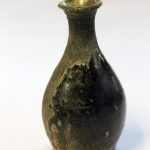“Purely derivative.” That’s a criticism that arises frequently in pottery commentary. Sometimes, “Merely reproductions.” But such complaints beg the question: Derivative or reproductive of what? And what of the work itself? Is it good pottery or bad?
If the object were one of avoiding patent or copyright infringement, the solution would be simple: “Purely original.” Or, “Merely unique.”
“The nail that sticks out,” goes a well-known Japanese saying, “gets hammered down.” Sadly, that remains the guiding principle in Japanese schooling and in Japanese society at large. Rare is the mentor of influence who encourages the up-and-coming to be nails that stick out, to “resist much, obey little” (in the words of the 19th-century American poet Walt Whitman).
Embellishing Japan’s persistent and justly notorious emphasis on submissiveness to group behavior is a rhetorical irony. To wit, those most prone to conformity in their actions seem to enjoy paying lip service to notions of originality and individuality. We should perhaps regard their utterances as expressions of a yearning born of repression.
The world of pottery is rich in quality work that inherits and conveys traits transported across the centuries as tradition. We also encounter inferior work, of course, that is subject to derision as “derivative.” But in taking issue with such work, let us focus on what’s wrong with it as pottery and not on our notions of what it supposedly resembles. And let us be equally rigorous in appraising work by allegedly “original” potters.






